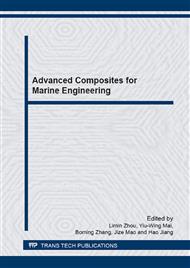[1]
K. Y Jhang, Nonlinear Ultrasonic Techniques for Nondestructive Assessment of Micro Damage in Material: A Review, International Journal of Precision Engineering and Manufacturing, 10 (2009) 123-135.
DOI: 10.1007/s12541-009-0019-y
Google Scholar
[2]
F.A. Bendera, J.Y. Kim, L.J. Jacobs, J.M. Qu, The generation of second harmonic waves in an isotropic solid with quadratic nonlinearity under the presence of a stress-free boundary, Wave Motion. 50 (2013) 146-161.
DOI: 10.1016/j.wavemoti.2012.08.009
Google Scholar
[3]
G. L. Jones, D. R. Kobett, Interaction of elastic waves in an isotropic solid, J. Acoust. Soc. Am. 35(1963) 5-10.
Google Scholar
[4]
F. R. Rollins, Interaction of ultrasonic waves in solid media, Appl. Phys. Lett. 2 (1963) 147-148.
Google Scholar
[5]
L. H. Taylor and F. R. Rollins, Jr., Ultrasonic study of three-phonon interactions. I. Theory, Phys. Rev. 136 (1964) 591–596.
Google Scholar
[6]
M. Liu, G. Tang, L. J. Jacobs, J. Qu, Measuring Acoustic Nonlinearity By Collinear Mixing Waves. Review of Progress in Quantitative Nondestructive Evaluation, 1335 (2011) 322-329.
Google Scholar
[7]
M. Liu, G. Tang, L.J. Jacobs, J. Qu, Measuring Acoustic Nonlinearity Parameter Using Collinear Wave Mixing, Journal of Applied Physics, 112 (2012) 024908.
DOI: 10.1063/1.4739746
Google Scholar
[8]
A.J. Croxford, P.D. Wilcox, B.W. Drinkwater, P.B. Nagy, The use of non-collinear mixing for nonlinear ultrasonic detection of plasticity and fatigue. J. Acoust. Soc. Am. 126(2009) 117-123.
DOI: 10.1121/1.3231451
Google Scholar
[9]
S. Küchler, T. Meurer, L.J. Jacobs, J. Qu, Two-dimensional wave propagation in an elastic half-space with quadratic nonlinearity: A numerical study, J. Acoust. Soc. Am. 125 (2009) 1293-1301.
DOI: 10.1121/1.3075597
Google Scholar
[10]
L. Azar, Y. Shi and S.C. Wooh, Beam focusing behavior of linear phased arrays, NDT&E International, 33 (2000) 189-198.
DOI: 10.1016/s0963-8695(99)00043-2
Google Scholar
[11]
A. Kurganov, E. Tadmor, New high-resolution central schemes for nonlinear conservation laws and convection-diffusion equations, J. Comput. Phys. 160 (2000) 241–282.
DOI: 10.1006/jcph.2000.6459
Google Scholar
[12]
Information on http: /www. cscamm. umd. edu/centpack/software.
Google Scholar
[13]
R.J. LeVeque, Finite Volume Methods for Hyperbolic Problems, Cambridge Texts in Applied Mathematics , Cambridge University Press, Cambridge, (2002).
Google Scholar


